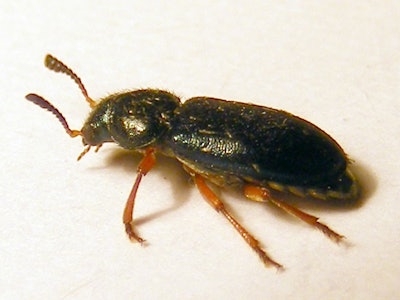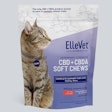
The red-legged ham beetle (Necrobia rufipes) was recorded in commercial pet food for the first time in Paraiba State in northeastern Brazil. Last year, after the pest was discovered in a supermarket in Campina Grande, a sealed 10 kg dog food bag was transported for testing to the Laboratory of Insect Systematics and Bioecology at the State University of Paraiba. Their analysis, published in Entomological News, found over 900 larvae and 500 adult beetles infesting the bag.
Similarly, N. rufipes in pet food was also recorded in Turkey in 2019. Published by researchers at the Department of Parasitology, Faculty of Veterinary Medicine, Ankara University, testing found 180 larvae and 350 adult beetles in pet food samples collected from Ankara pet clinics.
Pet food pest also found in Rio de Janeiro, Europe
Unlike Turkey, this is not the first time Brazil has recorded this pest in pet food. The beetle was previously reported in southeastern Brazil in 2000 and in Rio de Janeiro supermarket pet food in 2003. Since 2015, several reports of N. rufipes have also been recorded in European pet food warehouses and retail pet stores, particularly in the Mediterranean countries.
Thought to be a scavenging pest, N. rufipes is now understood to be omnivorous, predating on other pet food pests, too. It has historically been known for its affinity for meats, but with improved refrigeration standards for meat products, the beetle has begun emerging as a dried fish and pet food pest as well.
Ongoing research into management strategies
These various scientific recordings conclude that the pet food industry is at risk from N. rufipes due to the high concentration of crude protein in pet food and the beetle’s preference for carton packing materials, from where they gain entry, at packaging or storage sites. Early detection and prevention techniques for N. rufipes remain the subject of ongoing research, with management strategies being studied including controlled atmosphere, irradiation, botanicals, contact insecticides and fumigation.
With reference to sanitation, training of staff for thorough cleaning of factories, storage facilities and retail sites with cyfluthrin spray is recommended, as sanitation alone has shown limited success in eliminating the adult form of N. rufipes. With the recent phase-out of methyl bromide as an effective fumigant for controlling N. rufipes and other pet food pests, the search is on for other alternatives; propylene oxide and ethyl formate have shown promise.















